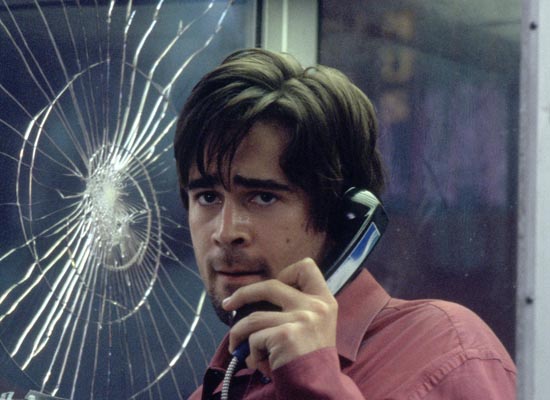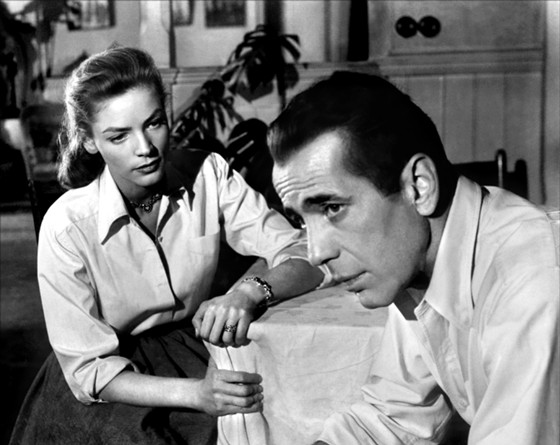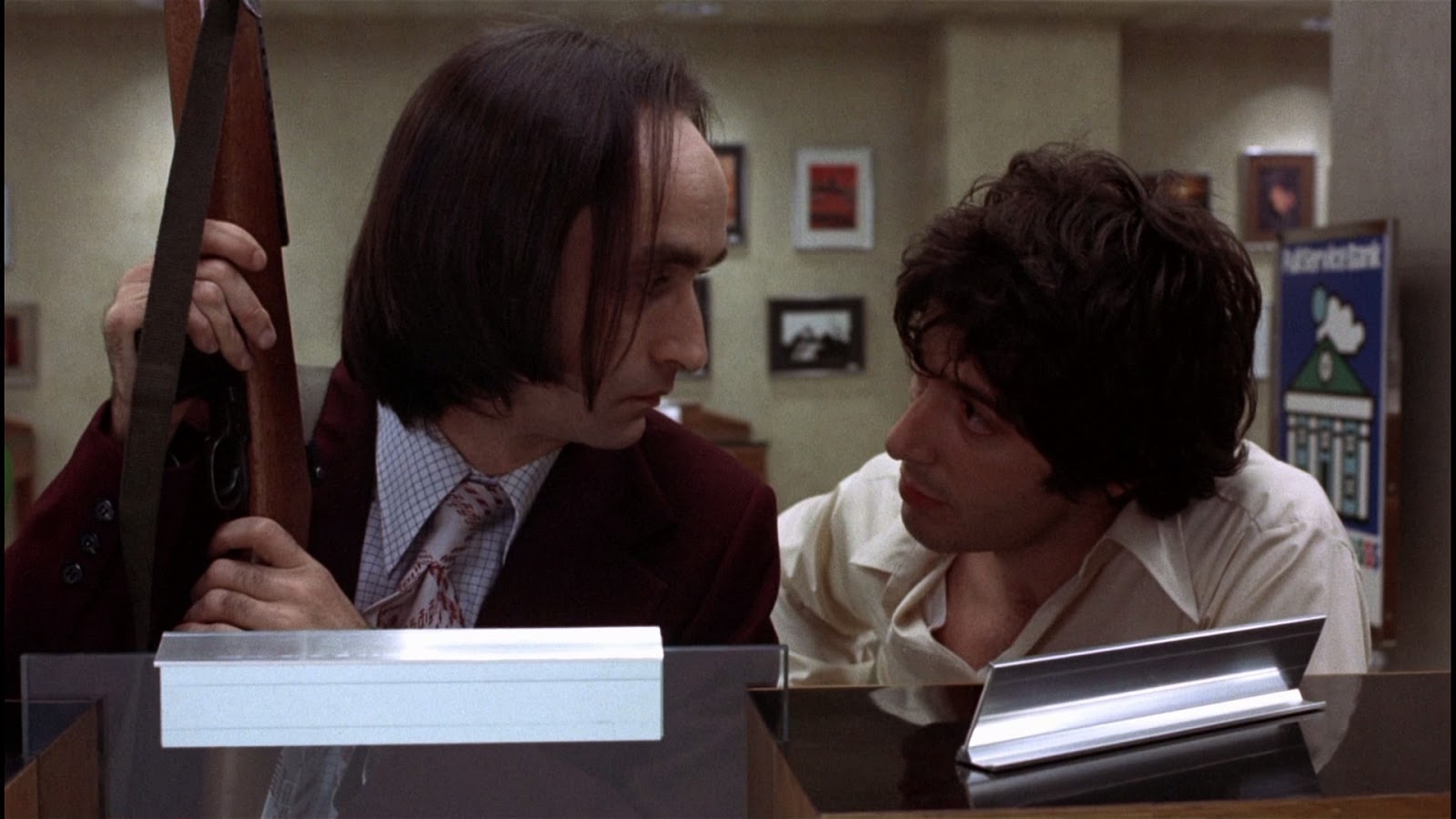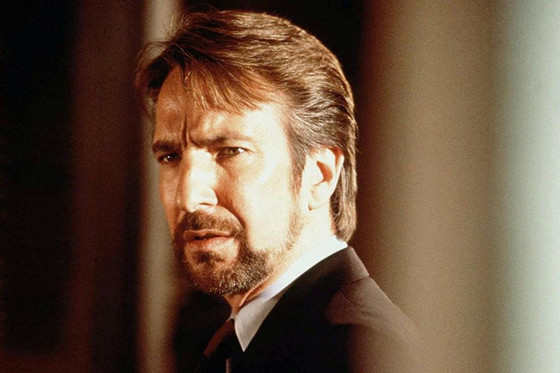5. Phone Booth (2002)

The premise for 2002’s Phone Booth had been kicked around studios since the 1960’s, when writer Larry Cohen caught the interest of Alfred Hitchcock, who dropped the concept when he was unable to come up with a believable cause. The story in question, regarding a film that takes place entirely within a phone booth, would then be dug up and buried once more in the 1990’s. Finally, at the turn of the new millennium, with Cohen’s epiphany of a sniper, the film was picked up by director Joel Schumacher and newly minted star Colin Farrell. The results were claustrophobic to say the least.
The man in the booth is Stu Shepard (Farrell), a loudmouth publicist with a penchant for fast talk and adulterous habits. He randomly answers a call by a man (Kiefer Sutherland) who claims to have him at gunpoint. Now, with a sniper’s scope on his chest, Stu is forced to play puppet to a man whose agenda is unclear and seemingly unprovoked. It may have taken decades to manifest, but Cohen’s brainchild formulates with brilliant clarity and clinically pinpoint pacing.
Farrell is frazzled perfection in the lead role, capturing cocky, frightened, regretful and whatever else human beings are able to feel when held at gunpoint for 80 minutes. Working off of Sutherland’s ominous baritone without a second’s rest, his gung-ho acting is the highlight of an otherwise average career. As for Schumacher, a director rarely associated with the suspense genre, he manages to put on the facade on a master specialist with split-screen sequences and camera angles that keep the same phone booth setting fresh. While a premise as juicy as this often falls victim to underwhelming results, the director and his star squeeze every ounce of excitement from this deceptively layered yarn. Hitchcock would’ve been proud.
4. Speed (1994)

LAPD cop Jack Traven (Keanu Reeves) has his work cut out for him when a presumed dead terrorist (Dennis Hopper) returns and straps a bomb to a city bus. Now Jack has to join forces with boisterous passenger Annie (Sandra Bullock) and keep the bus going above 50 miles per hour until his partner (Jeff Daniels) finds a way to disarm it.
Simple, corny, awesome. Jan de Bont’s (literally) explosive blockbuster is still a perfect example of what makes the hostage premise so ideal to the action genre. It provides such a clear cut goal for the hero that de Bont and screenwriter Graham Yost are able to fill up the spaces in between with clever set pieces, charming chemistry, and a pace that charges ahead faster than the runaway bus bomb. There’s never a moment where the filmmakers attempt to outsmart either the genre or the viewer, and this upfront approach works like a charm. Especially when it comes to action sequences, as each set-up builds upon the last like a testosterone soaked house of cards before crashing down with the climactic subway chase.
The acting is surprisingly stacked for a movie of this stature, backed by Daniels, Joe Morton, and a gonzo Dennis Hopper having the evil time of his life. Bullock charms the pants off the audience in her breakout role, and Keanu Reeves is uber-cool in the lead role, a guy born to wear a white t-shirt and take over-the-phone pop quizzes. As an action film, a hostage film, or just a film in general, Speed showcases all the fun that can be had with some hostages and a well placed bomb (fictionally, of course).
Character depth and emotionally skilled subtext are always encouraged, but there aren’t many movies where three separate hostage scenarios are successfully played out. In a way, Speed is almost overqualified for a spot on the list.
3. Key Largo (1948)

As is the case with the other two Humphrey Bogart hostage films (The Petrified Forest and The Desperate Hours), Key Largo is based on a 1939 stage play. It spins the tale of an ex-GI (Bogart) who drops down to Florida in the hopes of meeting his late buddy’s family, only to be taken in when deported gangster Johnny Rocco (Edward G. Robinson) decides to make his presence known via gunpoint and goons.
Cinematically speaking, Key Largo is what’s often referred to as “a clinic in acting.” A hostage standoff without the luxury of vulgarity or abhorrent violence is left only with the interest of its captives, and this film makes a strong case for it being the only ingredient needed. Director John Huston, who excelled at big screen adaptations (The Maltese Falcon, Moby Dick), marvelously swaps each body between the foreground and background of the frame, ensuring that not a single image goes by without an engaging bit of business to be seen. And in doing so, Huston allots an opportunity to showcase only the best of each performer, be it Lionel Barrymore’s reprimanding of Rocco or Claire Trevor’s boozy turn as Best Supporting Actress.
Bogie is terrific per usual, playing his stock-in-trade hero through the window dressing of an anti-hero, and rising to the occasion only when he’s needed most. Though fans in 1948 were surely miffed at the realization his G.I. and Lauren Bacall’s widow weren’t romantically involved, the film’s avoidance of such a predictable turn keeps things fresh from a storytelling perspective. Better yet, it allowed Bogart the opportunity to spar with Edward G. Robinson; a verbal event that’s easily worth the price of admission. Though co-stars in the past, Key Largo is their ultimate collaboration, a tough guy match made in heaven, running on the sparks of onscreen experts.
The finale of the film is surprisingly action packed for what originated onstage, but Largo maintains an air of old school angst even on the open sea. Good trumps evil, all is well with the world, and every other vestige of Golden Age Hollywood is delivered front and center. But when the delivery is this immaculately entertaining, a blind eye to predictability seems the least viewers could do.
2. Dog Day Afternoon (1975)

So often are the men behind the guns glamorized as quick-thinking pros or unleashed psychotics that viewers can forget they’re people too. Same reservations, same risks, same relief when things go right. And it’s for all these reasons and more that Dog Day Afternoon remains one of the most brilliantly formed hostage films to ever hit the big screen. Based on the true events surrounding a heist gone wrong in 1972, it bypasses cliche and goes right for the empathetic gut of the audience.
Much of the investment is directly linked to the lead performances of Al Pacino and the late great John Cazale. As Sonny, the brains of the operation, Pacino sets the silver screen ablaze with a neurotic edge and enough wily hair to ensure he was miles away from the sleek Michael Corleone. Whether pettily arguing with hostages or making the most iconic negotiation speech of all time (Attica, anyone?), the role cemented the young actor as an all time great.
Cazale, on the other hand, channels Fredo Corleone to crippling levels of simplicity. Playing the muscle of the morbid situation, his portrayal of Sal is one of pathetically low self-esteem, and his older brother idolization of Sonny does little to benefit anyone involved. If awards were passed out for the most clueless captors in cinema history, these two would sweep away the competition.
Complimenting his characters behind the camera was the far more competent Sidney Lumet, who was in the midst of a career defining decade. By toning down the back alley bleakness of 1973’s Serpico, Lumet offers up his most flamboyant take on New York City, complete with diegetic soundscapes and a summertime heat that bounds off the frame. In hyping up the news frenzy behind such a messy occurrence, the director captures both the intimacy of a hostage standoff and the far-reaching scope of modern media. After this film, the newscasters and journalists became just as integral to the situation as the police.
Whether discussing importance, quality, or sheer entertainment, Dog Day Afternoon is a success. The film allowed the men responsible to have their day in the sun, and though it burned them both, the audience was allowed a chance to understand why.
1. Die Hard (1988)

Even with all the grand gesturing and intense acting of other hostage films, Die Hard remains the apex of ass-kicking action cinema. It holds with it such an enormous sense of influence that every captive film released in its wake, regardless of genre, owes a tremendous debt. The premise, New York cop John McClane (Bruce Willis) holed up in an L.A. sky rise while foreign terrorists plunder millions, has become the very definition of a hostage movie – complete with shootouts and razor-sharp phone exchanges.
Arriving at the tail end of the 80’s adrenaline renaissance, Die Hard carried with it all the elements of a perfect storm; starting with director John McTiernan. As the man behind Reagan era classics likes Predator and The Hunt For Red October, McTiernan fleshes out an eye candy display of obscenity and violence, punctuated by an incredible knack for pacing. Each McClane encounter is perfectly staggered with buildup scenes of suspense, milking just the right amount of anticipation before a bloody battle ensues.
Also notable is the heavy incorporation of media and police involvement, a theme carried over from influences like Pelham 123 and Dog Day Afternoon that fluctuate to an all time high. But even amidst the hussle-and-bussle of a movie filled to the brim, the director makes damn near every sequence a staple of modern movie conventions. From here on in, every thriller with hostages would be referred to as “Die Hard on a (setting inserted here)”.
Unfortunately, for the decades worth of imitation projects that followed, few of them carried as engaging a cast as the original. Bonnie Bedelia, Reginald VelJohnson, and Paul Gleason all bring terrific interest to their roles, avoiding the typical shtick of damsels and cops while infusing an impressive amount of likability (except intentional prick Gleason). Bad guy Hans Gruber is the golden standard of snide terrorists, brought deliciously to life by the Count of curt himself, Alan Rickman. And as the hero, McClane, TV vet Bruce Willis nails the role that made him an international star, fueled on smart remarks and Robert Mitchum levels of swagger.
Die Hard is far from the most believable hostage film to hit the mainstream, but the excitement, heart, and charisma behind its nonstop spectacle bypass any qualms of authenticity. A cop, some bad guys, and a few bullets. Used correctly, it created the Best Hostage Movie of All Time. Yippee-kai-yay.
Author Bio: Danilo Castro is a freelance writer and editor of the Film Noir Archive blog. He has contributed and reviews to several publications including PopMatters, Noir City, and CinemaNerdz, spending much of his time watching classical Hollywood cinema. But if its not, that’s okay too.